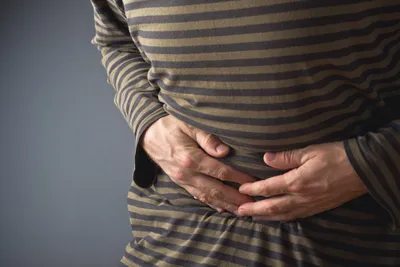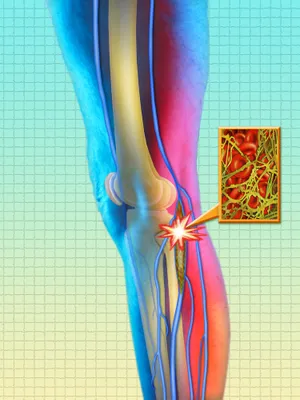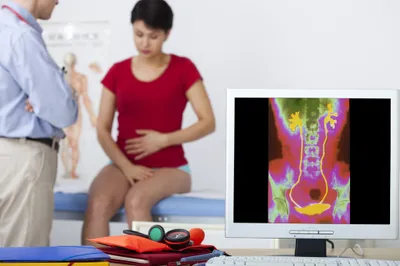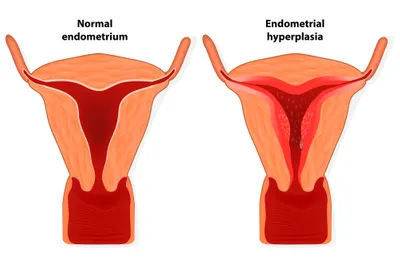While every single ache and pain you experience shouldn’t put you on edge—there are certain sharp pangs, fevers, and headaches that come on with excruciating swiftness and spell a healthy distress that should never be ignored.
These eight discomforts require immediate medical attention…
1. Appendicitis Pain
If the appendix ruptures, it’s an agonizing stomach pain to the lower right of abdomen that’s almost impossible to ignore. However, gastroenterologists from Cambridge Health Alliance, a Harvard-affiliate, describe an irritated appendix, or one in distress, as an ache that begins at the tummy center (or belly button) and gradually moves over to the right hand side.
Once the appendix bursts, which can take up to 24-hours, bacteria will filter into your bloodstream throughout the whole body, which is why a trip to the emergency room is imperative. An untreated ruptured appendix (meaning one that burst) will spill infectious materials (or waste) into the abdominal cavity, eventually causing peritonitis, the severe and dangerous inflammation of the perineum (which is the protective lining of the abdominal cavity. Emergency treatment (usually surgery and/or antibiotics will prevent death.
2. Deep Vein Thrombosis
If a small, but deep spot on your calf becomes increasingly tender, red, and hot to the touch, experts from the Mayo Clinic say that you could be dealing with a blood clot that’s developed deep within a vein. Deep vein thrombosis (or DVT) will cause rapid pain usually accompanied by swelling. Your best interest is to get to the hospital as soon as possible to prevent the clot from dislodging, obstructing blood flow and/or moving into the lungs, heart (causing a heart attack), or brain (resulting in a stroke).
According to research from the Centers for Disease Control and Prevention (CDC), deep vein thrombosis (DVT) most typically occurs in deep veins of the lower extremities. It requires emergency attention to prevent a portion of a blood clot from breaking off and lodging within the lungs. This will cause a potentailly fatal pulmonary embolism (PE), or lodge in the proximal lower extremity veins (popliteal, femoral, or iliac veins) again causing a life-threatening. PE.
3. Kidney Infection
A kidney infection will cause a deep, dull pain in your mid-back that worsens to downright miserable fairly quickly. Usually, the pain will be met with an equally nasty fever and nausea. These flu-like symptoms rear their ugly heads when bacteria from the urinary tract (or a UTI) proliferates the kidneys, by this time you’ll have a nasty infection on your hands that’ll cause you to experience pain when urinating and worsening fever and pain.
Health experts from the U.S. Department of Health recommend getting a suspect kidney infection attention as quickly as possible, as infection can lead to permanent kidney damage, chronic kidney disease, complications if pregnant including low weight babies, blood poisoning, and complete kidney shutdown, without the proper antibiotics.
4. Aneurysm
Those who suffer and live through an aneurysm describe it as the worst headache they’ve had in their entire lives. If you’re familiar with a migraine, it’s worse and minus the nausea. Often described as a “thunderclap” headache by neurologists, this pain strikes your head like a sudden clap of thunder and peaks within 60 seconds, this headache pain is a potentially life-threatening sign of an aneurysm, a balloon-like area in an artery or a rupture that causes bleeding in the brain.
Although an aneurysm can develop anywhere in the body, according to the Mayo Clinic, the two different types of aneurysm–cerebral aneurysm (which forms in the brain) and aortic aneurysm (which forms in the heart’s aorta wall). Aneurysms can also affect either sex, however, they are more prevalent in more common in males over the age of 65-years old. If you feel this characteristic headache, don’t take aspirin, just call 911 right away!
5. Endometriosis Pain
There are menstrual cramps that cause us to spend the day in bed, and then there are menstrual cramps that linger and don’t alleviate with medication and a heating pad. The later can mean endometriosis; a condition that the Cleveland Clinic says causes the lining of the uterus to develop in non-cancerous cells outside of the uterus, in other parts of the body.
The condition can lead to unbearable pain—typically before and during periods and during or after sex—and infertility if left untreated. Also, untreated endometriosis can lead to difficulty conceiving, the development of painful lesions, and infertility. Although the condition is incurable in some cases, treatment will work to lessen discomfort and increase pregnancy chances. If you experience symptoms of endometriosis, tell your doctor, who will likely start with oral contraceptives to deter abnormal cell growth. In worse cases, the excess tissues may have to be removed surgically.
6. Heart Attack Pain
You, like many people may believe that a heart attack causes chest pain and pressure (akin to an elephant sitting on your chest). However, that’s not always the case, according to the National Heart, Lung, and Blood Institutes, which say symptoms can be subtle, especially for women. A heart attack more commonly causes sharp, sudden pains between your shoulder blades or left shoulder or arm, shortness of breath, nausea, and dull jaw pain.
One study featured in the Journal of the American Medical Association Internal Medicine, which reviewed the patient data of over 1,000 young patients found that one in five women, under the age of 55-years-old, had no chest pain when stricken by a heart attack. The study concluded that females are likely to feel chest pain due to a heart attack compared to males. If you experience what you believe is heart attack pain, call 911 for immediate attention.
7. Burning Feet or Legs
Take it from the American Diabetes Association, who claims that roughly 23 million individuals in the U.S. have diabetes, but are unaware and undiagnosed. Chances are the first indication of an issue is peripheral neuropathy, or chronic pins-and-needles in the feet and/or legs. This burning sensation usually indicates diabetes-related nerve damage. However, you may feel characteristic tingling, throbbing, numbness, shape pains, and the sensation of being poked by several pins in the affected area.
According to the Canadian Diabetes Association, nerve damage associated with diabetes (or diabetic peripheral neuropathy) is a long-term complication that results from exposure to high blood glucose levels over long periods of time. The heightened blood glucose often results in severe peripheral nerve damage to the extremities, mainly the feet, toes, legs, arms, and hands. If left untreated, diabetes-related diabetic peripheral neuropathy can lead to foot ulcers and total amputation.
8. Tooth Nerve Pain
If your toes literally curl and your hair stands on end whenever your teeth meet something cold, you may have an exposed nerve. This is typically caused when the surrounding enamel on your teeth becomes damaged, cracked, or is in decay. According to U.S. dental professionals, your health is put at risk if a mouth bacterium contaminates the nerve, which can occur quite quickly without a filling, or root canal and a series of antibiotics if infection has occurred.
Tooth bacteria that contaminates a nerve can quickly turn into an abscess that develops in an infected partof the mouth, face, jaw or throat. Abscesses develop when bacteria invade a dental pulp (or the soft inner portion of the tooth, made up of nerves, tissue, and blood vessels) and infects the root of the tooth. An abscess will cause severe swelling as pus (a combination of white blood cells, bacteria, and dead tissues) accumulate. If unchecked, a bacterial infection can spread quickly from the tooth root and infect all areas of the body.











